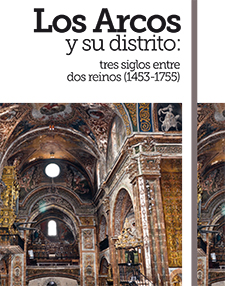LOS ARCOS AND ITS DISTRICT: THREE CENTURIES BETWEEN TWO KINGDOMS (1463-1753)
15 September 2016
Another jewel of the Renaissance in Navarre: the altarpiece of San Andrés de El Busto
D. Pedro Luis Echeverría Goñi. University of the Basque Country
Among the exceptional Mannerist group of "Riojan altarpieces" from the second third of the 16th century, the one that presides over the presbytery of the parish church of El Busto stands out in Navarre, after those of Genevilla and Lapoblación. Although its language corresponds more to the reign of Emperor Charles, it was executed a few years after Philip II came to the throne, while its gilding and estofado were contracted two years after "the prudent king" ratified the charters of the Castilian town of Los Arcos in 1571. This work and its Counter-Reformationist polychromy were authorised and supervised by the visitators general of the bishopric of Calahorra and La Calzada, to which this town belonged, and which was governed by Don Juan de Quiñones y Guzmán, a prelate who took an active part in the last sessions of the Council of Trent.
In 1560-1561, Martín Gumet (+1577), a French assembler, was in charge of its architectural structure. His first appearance on the Peninsula is recorded in Oñate, working on the works of the University of Sancti Spiritus, together with other Gallic compatriots such as the carver Pierres Picart, with whom he may have arrived in Navarre around 1555. He settled in Los Arcos, where he had four children and died, his tombstone being preserved at Shrine of Our Lady of Fair Love de San Sebastián. In this Castilian town he established his workshop in which his son Diego, the carver from his first marriage, and the sculptor Juan Ruiz de Heredia, among others, collaborated. He is the author of the architecture of the altarpieces of Genevilla, Piedramillera, El Busto and the one in Agoncillo in La Rioja, as well as the choir stalls and the lectern of Los Arcos. In 1563 he competed for the auction of the main altarpiece of the church of San Juan Bautista in Estella, together with other Welsh masters such as the carvers Pedro de Troas, Esteban Bertin de Paris and Pierres Duran de Perona, better known as Pierres Picart, who would eventually be the successful bidder.
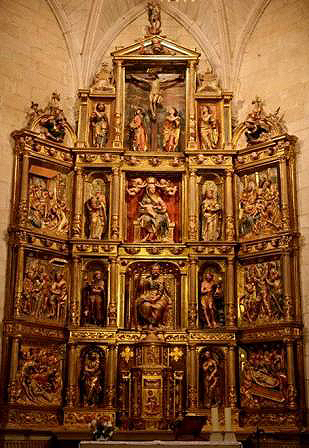
El Busto. Parish Church of San Andrés
Main altarpiece
Its iconographic programme tells a story of redemption and, as such, begins with themes from the Passion of Christ and culminates with the Calvary in the attic. In the tabernacle, the Ecce Homo on the door, inspired by an engraving by Dürer, is superimposed between Saint Peter and Saint Paul and the Flagellation, flanked by Saint John and Saint Mark, the evangelists who best tell the story of this cycle. The apocryphal topic of the Lamentation contrasts the diagonals of the dead Christ, similar to that of a Raphaelesque engraving by Marcantonio Raimondi, and that of the Virgin collapsed in grief. The same composition is used in two reliefs from the Agoncillo altarpiece and another attributed to Pierres Picart, which is in the National Museum of Sculpture in Valladolid. In the high relief of the Holy Burial, as in another of the same name in Valladolid, the diagonal arrangement of the sarcophagus in which the dead Christ is placed is striking, beneath which lions emerge to symbolise the resurrection.
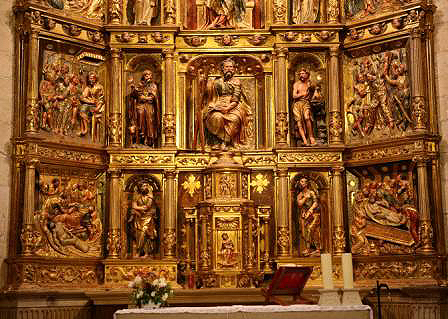
The iconographic programme of the main altarpiece tells the story of redemption.
The seated carving of Saint Andrew in the first section is flanked by the stories of the Trial before Aegeas and the Crucifixion. The saint dressed in a tunic and tied to an aspired cross is an update of German engravings such as that of H. Schaufelein, while for the sayons we find affinities with those of another print by M. Wolgemut with the same title topic. Presiding over the second body, as mediator between mankind and Christ on the Cross, is the seated Virgin and Child with the ball of the world; it is an image of great elegance that describes a serpentine line. She is depicted as the queen of heaven, crowned by two angels. In the magnificent reliefs of the Adoration of the Shepherds and the Epiphany, the figures adoring the Child draw circular compositions, i.e. the perfect geometric form in the Renaissance associated with divinity.
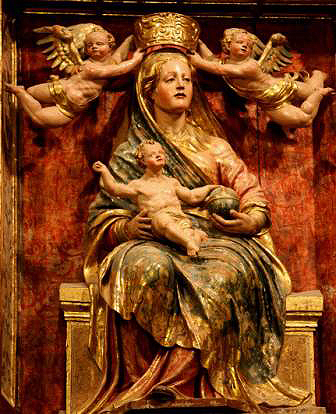
The second body is presided over by the elegant image of the Virgin Mary
who acts as intercessor between mankind and Christ.
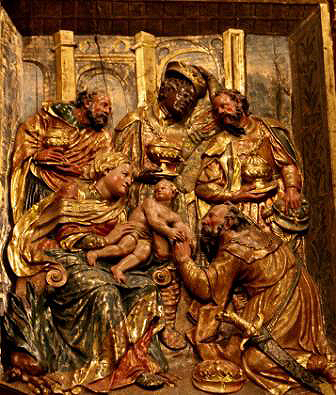
In the Epiphany the characters are arranged in a circular composition.
The Calvary in the attic is composed of an expressive Christ between the Virgin and Saint John, with serpentine lines as an expression of their pain; on the back panel Francisco Fernández de Vallejo demonstrated his skills as a brush painter with a beautiful landscape that contrasts with the elementary little trees carved in the relief of the Lamentation. The Eternal Father on the pediment presides over the altarpiece, reminiscent of the creator God of the Sistine Chapel, with his hair and beard, and affirming his superior rank with an imperial crown. The Old Testament, which prefigures the New Testament, can be seen in the two prophets in the tympanums at the top of the altarpiece, of which the one in the epistle is identified by his phylactery as Isaiah; likewise, the reliefs of a sibyl and another prophet facing each other can be seen in the netting at the ends of the predella.
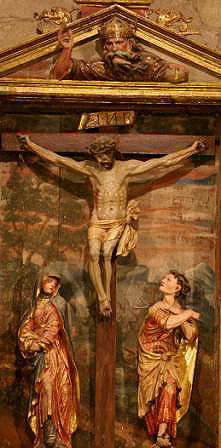
High altarpiece. Calvary
The interspaces serve as framework for carvings of saints of local, regional, Navarrese and international devotion. On the bench flanking the tabernacle are the carvings of two apostles, of which the one on the epistle side is inspired by Marcantonio Raimondi's Saint Bartholomew. To the right of the main figure is Saint Anthony the Abbot, patron saint of animals and advocate against the plague, who follows an engraving of Saint Severinus by Dürer. On the other side is Saint John the Baptist, who bears an extraordinary resemblance to the carving of the same name in the Huarte Araquil altarpiece by Pierres Picart. In the second section we see the carving of a cephalophoric saint and a bishop saint; the former represents Saint Nicasius, bishop of Reims; the origin of this representation is in a 1500 woodcut of Saint Dionysius of Paris, and his devotion was very popular in Navarre; in Tierra Estella it is earlier and its representation in an altarpiece from 1402 in the church of San Miguel de Estella, now in the National Archaeological Museum, can be found at reference letter . In a town on the Pilgrim's Way to Santiago de Compostela, a carving of St. James the Pilgrim could not be missing, such as the one in the attic, which describes a serpentine line similar to the one on the same topic of the Lapoblación altarpiece, the work of Arnao de Bruselas; on the other side appears St. John the Evangelist. At the apex of the crowning pediment is a small image of Saint Michael the Archangel with the devil at his feet, who dominates from on high. This dedication, so popular in Navarre, can be seen again shortly afterwards on the pediment of the main altarpiece of San Juan Bautista in Estella.

Main altarpiece. San Nicasio
El Busto's expressive style is characterised by the figures of profile, with broad foreheads, aquiline noses, waving hair and beards and mouths half-open in a longing expression, like those seen in some of Marcantonio Raimondi's engravings. This mannerism of movement is defined by the multiple intertwining of legs in scissors, the serpentine lines, the folds in waves, the wet draperies and the boat necks, like those seen in the figures of Arnao of Brussels. In this altarpiece we have seen the early reception in Navarre of Michelangelo's models, such as the telamons which, like corbels, support the tabernacle; we are looking at the first versions of the Florentine genius's putti, ignudi and slaves symbolising the body as a prison for the soul, fifteen years before the arrival of Juan de Anchieta in the Old Kingdom. The energetic crossing of arms in front of the body that we see in an ignudi by Michelangelo or in the prophet or apostle by Bandinelli are repeated in various carvings in El Busto. The support of a foot on the Florentine's patterned plinth is repeated here in carvings such as that of Saint John the Evangelist. Michelangelo left us programs of study for seated figures such as Lorenzo de Medici or the Moses which served as model for the carving of Saint Andrew. Finally, we can see literal copies of sanguines with programs of study of the language of the hands in our altarpiece, such as the arm of one of the shepherds in the Nativity scene pointing to the Child, which is a literal copy of the arm of God the Father in the Creation of Adam in the Sistine Chapel.
The grotesques of the predella and the frieze of the bench represent the soul oppressed by the subject and the passions with masks, biches and bestiones, while the friezes of the bodies are crossed by the heads of little winged angels that symbolise in the Neoplatonic programmes the ascent of the soul to heaven once freed from the bonds of sin. The four-petalled flowers dotted in the foreground of scenes such as the Lamentation over the dead Christ or the Crucifixion of Saint Andrew can be considered true "signatures of style" in this altarpiece. Like the apostles carved by Arnao of Brussels, the booted figures in our altarpiece wear slippers, i.e. leather-soled shoes without heels tied at the ankle by leather straps. To summarise, I would like to reflect this story of the redemption of the human race by Christ on the cross through three images: the skulls and winged skulls, allegories of death, which are located in the lower parts of the counter-pieces of the bench; the lions, which appear under the tomb of the Burial of Christ and which, according to the Physiologist, symbolise the resurrection; and the friezes of winged cherubs, which represent the ascent of the soul to heaven.
PROGRAM
Wednesday, 14th September
Between Navarre and Castile (1463-1753)
D. Roman Felones Morrás. Lecturer in History of Art at classroom de la Experiencia. Public University of Navarra
Tasting and savouring: the arts at the service of the senses in the parish church of Los Arcos
D. Ricardo Fernández Gracia. University of Navarra
Thursday, 15th September
Another jewel of the Renaissance in Navarre: the altarpiece of San Andres de El Busto
D. Pedro Luis Echeverría Goñi. University of the Basque Country
Stone and stonework at the service of the Church and the nobility in Sansol
Ms. Pilar Andueza Unanua. University of La Rioja
Friday, 16th September
Armañanzas: in the footsteps of its church, altarpieces and emblazoned houses
José Javier Azanza López. University of Navarra
The artistic heritage of Torres del Río: much more than the Santo Sepulcro (Holy Sepulchre)
María Josefa Tarifa Castilla. University of Zaragoza
Saturday, 17th September
visit Guided tour to Torres del Río, Armañanzas, Sansol, El Busto and Los Arcos.

